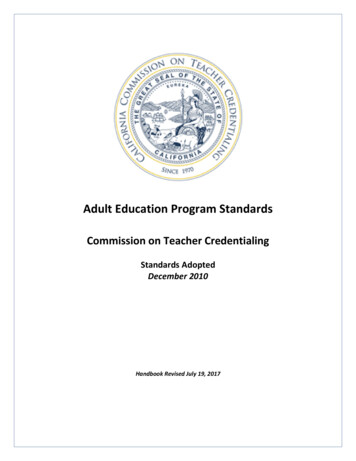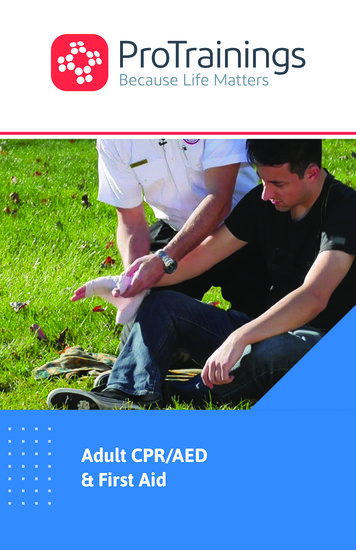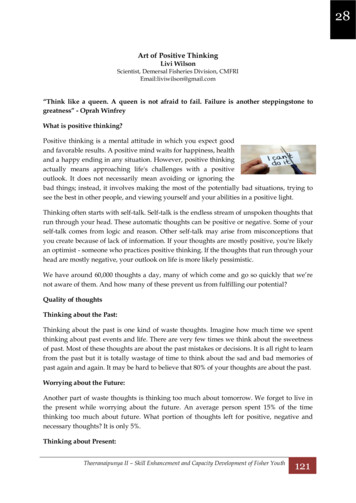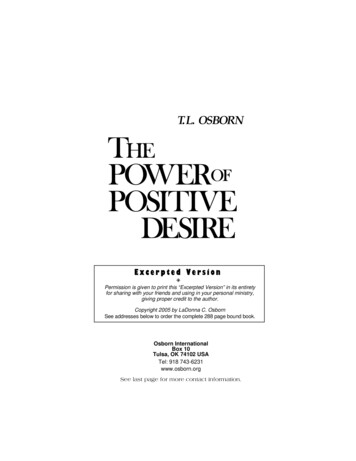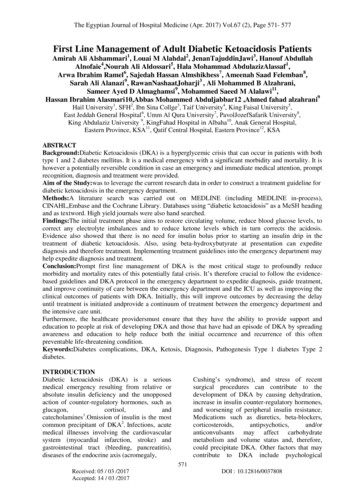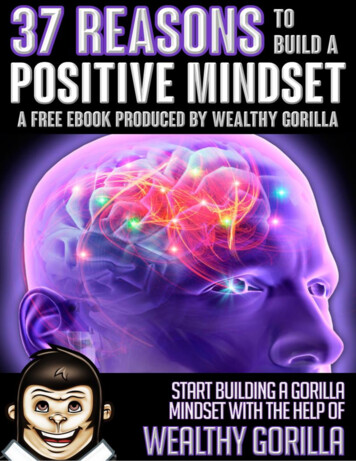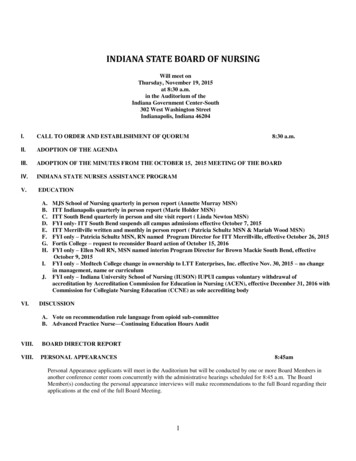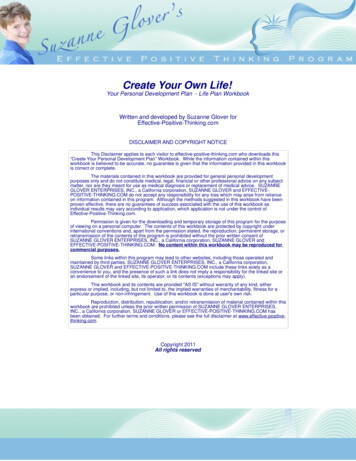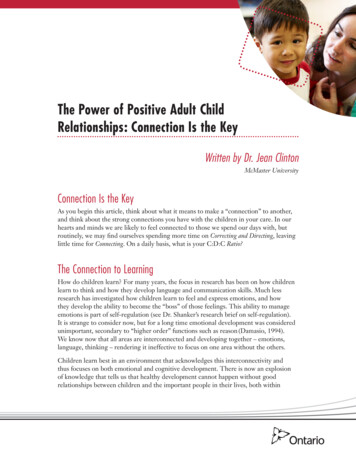
Transcription
The Power of Positive Adult ChildRelationships: Connection Is the KeyWritten by Dr. Jean ClintonMcMaster UniversityConnection Is the KeyAs you begin this article, think about what it means to make a “connection” to another,and think about the strong connections you have with the children in your care. In ourhearts and minds we are likely to feel connected to those we spend our days with, butroutinely, we may find ourselves spending more time on Correcting and Directing, leavinglittle time for Connecting. On a daily basis, what is your C:D:C Ratio?The Connection to LearningHow do children learn? For many years, the focus in research has been on how childrenlearn to think and how they develop language and communication skills. Much lessresearch has investigated how children learn to feel and express emotions, and howthey develop the ability to become the “boss” of those feelings. This ability to manageemotions is part of self-regulation (see Dr. Shanker’s research brief on self-regulation).It is strange to consider now, but for a long time emotional development was consideredunimportant, secondary to “higher order” functions such as reason (Damasio, 1994).We know now that all areas are interconnected and developing together – emotions,language, thinking – rendering it ineffective to focus on one area without the others.Children learn best in an environment that acknowledges this interconnectivity andthus focuses on both emotional and cognitive development. There is now an explosionof knowledge that tells us that healthy development cannot happen without goodrelationships between children and the important people in their lives, both within
the family and outside of it. As Dr. Jack Shonkoff states,“young children experience their world as an environmentof relationships, and these relationships affect virtually everyaspect of their development” (National Scientific Councilon the Developing Child, 2004). Relationships are theactive ingredient in healthy development, especiallybrain development.Social and Emotional Learning (SEL) is a term used todescribe the process through which children (and adults)develop skills to support their success in learning,forming good relationships, solving problems, andadapting to new situations - skills such as self-awareness,self-control, the ability to work cooperatively with othersand to be caring and empathetic (Goleman, 2006).Social and Emotional LearningHow do children learn about the world? Babies are born learning. When they interactwith others, babies are like little scientists, observing faces and gestures and noticingeverything around them. Dr. Andy Meltzoff has shown that babies as young as onemonth begin to imitate faces (Meltzoff, 1977). By one year of age they turn to see mom’sreaction when they are shown something new— “If there’s a smile, they’ll crawl forwardto investigate; if there’s horror, they’ll stop dead in their tracks” (Gopnik, A., Meltzoff,A. N. & Kuhl, P., 2008, p. 33). They learn to soothe themselves by being soothed. It’s atwo way street of serve and return (National Scientific Council on the Developing Child,2004). We are wired to connect to others.Infant, Toddler and Preschooler’s WorldThis holds true for other age groups as well. The world of infants, toddlers andpreschoolers is one of extraordinary brain activity and learning. We all learn byobserving others and we seek connection and relationship. Our brain is a social organ– wired to reach out and help others. Why is that so – likely for survival. Our babiesand young children need far more protection than other mammals. A couple of veryinteresting experiments illustrate that we start to show empathy and a desire to helpvery early in life. Dr. Karen Wynn’s research at Yale is fascinating. She has 6-month-oldbabies watch animated circles and squares or puppets act out a mini drama. Some helpa little character up a hill, some push him down. When given the choice to play witheither puppet, most babies prefer the helper (Bloom, 2010). In another experiment, anadult tries to put books in a cupboard but instead of opening it he just keeps bangingagainst it. The 18-month-old children in the study spontaneously come and open thecupboard for him. He never looked at them for help, they just knew. How? From all ofthe observing and relationship cues they had been receiving and responding to all theirlives (Warneken & Tomasello, 2009).2 Th e P o w e r o f Po sit iv e A d u lt - C h ild R e la t io n s h i ps: Co n n e ct i o n i s t h e k e y
Implications for Caregivers and Early Childhood EducatorsWhat implications are there for caring for young children? A lot depends on what ourmindset is and how we view our role. What do we understand our job to be? What wethink, affects how we feel, affects how we act. For example, if we think that our job is toteach children all we can, so that they learn their numbers and letters and how to behave,then we may feel that kids need to do lots of things to learn and keep busy. We may actby setting up a program that mainly consists of adults directing the children throughactivities. This is concerning for several reasons. An adult-led emphasis on literacy andnumeracy means other things need to be left out and what too often gets left out are theopportunities for learning through play.As the Council of Ministers of Education, Canada (CMEC) so clearly states:“Experts recognize that play and academic work are not distinct categories for youngchildren: creating, doing, and learning are inextricably linked. When children areengaged in purposeful play, they are discovering, creating, improvising, and expandingtheir learning. Viewing children as active participants in their own development andlearning allows educators to move beyond preconceived expectations about whatchildren should be learning, and focus on what they are learning” (CMEC, 2012).In reflecting on this, some very well-meaning early learning centres noted they hadbeen putting children through many transitions in the day, in one example, as manyas 19. The challenge is, how can you build relationships with children if you arealways interrupting their work, directing them to the new activity or routine, andcorrecting them if they don’t follow your expectations for following the schedule? Incontrast, among a growing number of early learning and child care programs, fosteringrelationships with the children is a top priority. They feel that children learn best in anenvironment that focuses on relationships, and that if kids are strongly connected totheir teachers they will learn more and have less challenging behaviours. They thinkthrough the lens of “how will this affect our relationships with the children”. Theylook at how many transitions children go through and work to reduce transitions, andallow lengthy blocks of time where they can be connecting with the children throughindividualized care and play (Ministry of Education, 2007).For babies and children, care and teachingare inseparable. By thinking differently aboutlearning, that is, not as skills and informationtaught through direction, but rather as a lifelong process ignited by connection, we canfeel confident that learning is underway aswe interact in a warm and responsive manner.With more connection, there is less needfor correction and directing. When we trulyfollow what children are engaged in, we haveto connect more with the child and things gomore easily for all.Dr. Je an Cl i n t o n 3
Simple Ways to Build ConnectionsThings we can do are simple, but we need to make them more intentional. Here aresome examples of ways to build connections modified from the Center on the Socialand Emotional Foundations for Early Learning (Ostrosky, M. M. & Jung, E. Y., 2010): Be at the child’s level for face-to-face interactionsUse a pleasant, calm voice and simple language while making eye contactProvide warm, responsive physical contactFollow the child’s lead and interest during playHelp children understand your expectations by providing simple but clear explanations(not by directing)Take the time to engage children in the process of resolving problems and conflicts,rather than reiterating classroom rulesWhen children’s behavior is challenging and disruptive, think about where and howthey might have more success and redirect them thereFoster thoughtfulness and caring by listening to children and by encouraging them tolisten to others and share ideasBe genuine in acknowledging children for their accomplishments and effort by clearlysaying what it is they have done wellBeyond these specific strategies, adults can speed up the process of relationship-buildingby: Carefully analyzing each compliance task (e.g., “time to go to paints”) and shifting thatcompliance task to a choice for children (e.g., “Do you want to paint or do puzzles?”); and Carefully considering if some forms of “challenging” behavior can be ignored (e.g., loudvoice)—this is not ignoring behavior designed to elicit attention but ignoring in the senseof making wise and limited choices about when to pick battles over behaviour.When there is more connection, there is less need for correction and directing.As you can probably see by now, this shift in mindset naturally makes the C:D:C ratiobetter. As the connection goes up, the other C and D go down.Beware of the “Praise Trap”It is important to reinforce when children have done welland worked hard. Reinforcing this by saying “you reallyworked hard on that puzzle, didn’t you” or “I see you’vecollected all of the cars and put in them in the basket, that’swonderful Jack!” is much more informative than “good jobtidying” or “you are so smart.”The first type of praise encourages the child and fostersmotivation from within (intrinsic motivation), whereas the second type ofpraise can lead to children looking for reward or praise which typically meansthey work less (extrinsic motivation).4 Th e P o w e r o f Po sit iv e A d u lt - C h ild R e la t io n s h i ps: Co n n e ct i o n i s t h e k e y
What About School-Aged Children?What about school-aged children? The research shows the same results. Children’srelationships with others are what matter most. Children who are attuned to the adultsin their lives value their approval (Ostrosky, M. M. & Jung, E. Y., 2010). In school-ageprograms it is key to develop this focus right from the start. Too often, when a groupcomes together, the first thing we do is go over the rules. What does that set up interms of relationship expectations for the children? Will they start off by seeing you asenvironment managers (rule keepers) or relationship partners? What would it be likeif the first interactions are seen through the lens of relationship building? We can askchildren about themselves, what they like to do, what gets them really excited.The Center on the Social and Emotional Foundations for Early Learning atVanderbilt University (www.vanderbilt.edu/csefel) has a wonderful concept.They use a metaphor of a piggy bank for building positive relationships.They believe that “whenever teachers and caregivers engage in strategiesto build positive relationships, it is as if they are making a deposit in a child’srelationship piggy bank” and the best way to do this is by “embedding themthroughout the day” (Joseph, G. & Strain, P. S., 2004).Remember Our GoalsWhat is our goal in raising and working with young children? There are many viewsand many voices, but clearly we are learning that the quality of children’s relationshipswith the adults in their life has a huge lifelong impact. In fact, evidence is accumulatingthat when there is an emphasis on social and emotional learning, with a special focus onpositive adult-child interactions, children and young people do well.Durlak, in his large meta-analysis of social and emotional learning showed “that studentswho receive social and emotional learning instruction had more positive attitudes aboutschool and improved an average of 11 percentile points on standardized achievementtests compared to students who did not receive such instruction” (Durlak et al., 2011).And perhaps even more important for life skills, “it helps students become good commu nicators, cooperative members of a team, effective leaders, and caring, concerned membersof their communities. It teaches them how to set and achieve goals and how to persist inthe face of challenges” (Durlak et al., 2011). Who could disagree?Reflective Questions:1. In this article the words kind, caring, empathetic, warm, responsive and calm have been usedto describe the style of interactions that build connections. Think about these words inrelation to the character traits you value in yourself and others. How might you modifyyour teaching style to foster development of these traits in the children you care for?2. Would you enjoy your day more if you had more time for connecting with individualchildren or very small groups in play? Think about how you can change your dailyschedule to do so.Dr. Je an Cl i n t o n 5
3. As you think about this article, what would you consider an ideal Correction: Direction:Connection ratio? 1:2:200? There is no perfect answer but even just observing yourselffor a day will begin an important reflection.4. Will you share this article with parents and co-workers?Many thanks to Lois Saunders, RECE and Wanda St. Francois, RECE for their valuableinput and insights.ReferencesBloom, P. (2010, May 9). The Moral Life of Babies. New York Times, 44.Council of Ministers of Education, Canada. (2012). Statement on Play-Based Learning.Retrieved from /Attachments/282/play-based-learning statement EN.pdfDamasio, A. R. (1994). Descartes’ Error: Emotion, Reason, and the Human Brain. New York:Putnam Publishing.Durlak, J.A., Weissberg, R.P., Dymnicki, A.B., Taylor, R.D. & Schellinger, K.B. (2011).The impact of enhancing students’ social and emotional learning: A meta-analysis ofschool-based universal interventions. Child Development, 82(1), 405-432.Goleman, D. (2006). Social Intelligence: The New Science of Human Relationships. NewYork: Random House.Gopnik, A., Meltzoff, A. N. & Kuhl, P. (2008). The Scientist in the crib: What early learningtells us about the mind. New York: HarperCollins.Joseph, G. & Strain, P. S. (2004). Building positive relationships with young children.Young Exceptional Children, 7(4), 21-29.Meltzoff, A. N. & Moore, M. K. (1977, Oct 7). Imitation of Facial and Manual Gestures byHuman Neonates. Science, 198(4312), 75-78.National Scientific Council on the Developing Child. (2004). Young children develop in anenvironment of relationships. Working Paper No. 1. Retrieved from http://developingchild.harvard.edu/library/reports and working papers/working pape1/Ontario Ministry of Education (2007). Early Learning for Every Child Today: A Frameworkfor Ontario’s Early Childhood Settings. Retrieved from continuum.pdf Queen’s Printer for Ontario, 2013Ostrosky, M. M. & Jung, E. Y. (2010). What Works Briefs: Building Positive Teacher-ChildRelationships. Center on the Social and Emotional Foundations for Early Learning.Retrieved from ken, F. & Tomasello, M. (2009). The Roots of Human Altruism. British Journalof Psychology, 100, 455-471.6 Th e P o w e r o f Po sit iv e A d u lt - C h ild R e la t io n s h i ps: Co n n e ct i o n i s t h e k e y
develop skills to support their success in learning, forming good relationships, solving problems, and adapting to new situations - skills such as self-awareness, self-control, the ability to work cooperatively with others and to be caring and empathetic (Goleman, 2006). . it is as if they are making


